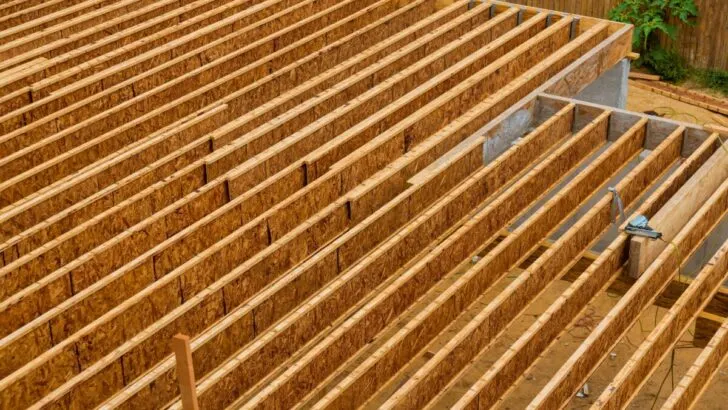The joists in your floor and ceiling are the backbone of your home’s construction. Carpentry is only complete with joists, which distribute a load of a structure’s frame entirely.
A rim joist is mostly attached perpendicularly to a joist when building a floor or deck system, giving the ends of the joists lateral support and capping it off from the end of your deck or floor system.
Now is the time to be patient and wait before getting out your toolbox because we will go over in depth what rim joists are, how they operate, and whether or not they are load-bearing in the following discussion. So, let’s get started.
What Is Considered a Rim Joist?
As stated earlier, the joists in your floor and ceiling are the backbone of your home’s construction.
After the framing is done, a plywood subfloor is installed over the floor joists, and the actual flooring is laid on top. Most joists are separated by at least 16 inches in the centre.
In short, a rim joist is a piece of wood that buts up to the floor joists and runs the length of the room to complete the framing. They are also known as band joists. You can tell the floor frame of a house is being built because of the strong lumber that runs along the outside of the structure.
A rim joist’s job is to support the other floor joists and provide them with strength and stability. Floor joists are secured from toppling over by butting their lower ends on a rim joist and nailing them into place.
Floor joists are kept level and upright by rim joists. The floor’s structural components are nailed directly to one another via the rim joists and the ends of the floor joists.
The rim joists on a conventional house rest on the top of a sill plate of the foundation wall.
When the plywood flooring is in place, the rim joist can support the construction of a wall. Rim joists are regarded as load-bearing in situations like this.
Some rim joists, such as those along a deck’s perimeter, may not carry any weight because they are not supported by anything above them. However, the rim joist is typically used in decks to support rails and steps.
What Is the Purpose of a Rim Joist?
A rim joist’s primary job is to support the other joists in the structure. They have an outer edge because they are attached to the ends of the inside floor joists. As a result, the joists remain solid, level, and upright.
Imagine you are constructing a deck. Over the base, you set up your floor joists at 16″ in the center, using 2x10s. What holds them erect? The rim beam.

To ensure the stability and straightness of the floor joists, wood is fastened onto their outer border. Floor joists are strengthened and prevented from toppling over by rim joists.
A house’s exterior is covered in rim joists. The majority of the time, rim joists are used as the foundation for exterior walls.
A footing supports the outside foundation wall, while rim joists are used to frame the exterior walls. Every component is crucial to the overall structure of the house.
The ends of every bay of joists are covered with rim joists. Typically, the rim joist is drilled through when a pipe or vent needs to be run from the basement through the outer wall, such as for a hose bib.
Sheathing can be nailed into rim joists, which provide a solid piece of wood for the nailing. Connecting the floor frame to the wall framing gives a house additional strength.
If a wall is constructed on top of the rim joist of a deck, only then is it regarded to be a load-bearing structure. However, it’s still crucial.
In the same way that floor joists within a home are supported and kept upright by them, they give the floor joists strength. To maintain the strength, fasten the railing posts to the rim joist.
Is a Rim Joist Load-Bearing?
When constructed correctly, rim joists can withstand loads and can help support exterior walls. In addition to this, rim joists provide a sturdy wooden surface that the sheathing may be nailed into.
The floor and wall construction are joined together by this sheathing, which helps to strengthen the building’s structural integrity.
Rim Joist vs. Band Joist
Two crucial components of a home frame are the band joist and the rim joist. Even though they both play comparable responsibilities, you need to be aware of some of their significant variances.
1. Size
The size is the primary characteristic that can be used to differentiate between the two types of a joist. Because they bear the floor load below, band joists are frequently made smaller.
Because of this, the rim joists need to be enlarged to provide the floor with sufficient support. This is necessary because you are adding another story on top.
2. Connection
Their method of connection is another distinction. A band joist, either hammered into position or supported by metal hangers, will serve as a bearing surface for the lower ends of your floors’ ceiling joists.
On the other hand, a rim joist has an L-shaped bracket rather than nails holding it together. This provides your ceiling layer with additional support and boosts the stability of your house.
3. Installation
They differ significantly in terms of installation as well. Both the band joist and the rim joist connect to the upper part of the foundation wall, and the rim joist also links to the floor framework.
This means that you must provide enough room between two objects to prevent rubbing.
The installation of a band joist typically involves using hand nails. When it comes to securing the rim joists, pneumatic nailers or other comparable instruments are commonly utilised.
On the other hand, the floor and rim system is kept together without the need for nails.
4. Strength
These joist types are part of a larger structural system. Therefore, their combined strength is an important consideration when choosing between them.
In proportion to depth, the band joist, often known as a sill plate, is frequently broader and thicker than the rim joist.
More stability and strength result from this. Although it can sustain a considerable amount of weight vertically, its width limits how far it may span horizontally without additional support.
5. Adaptability to Various Projects
The size and configuration of your space may also influence whether you employ band joists or rim joists. Tall ceilings would probably require additional support, so you might choose a band joist because it has extra support built into its design.
Additionally, larger rooms with horizontal floor shafts could look good with a rim joist compared to the straight bands usually used between the flooring boards. This is because a rim joist suits this form better than straight bands.
Final Words to Rim Joists
The joists in your home are essentially the support structure. They lend the framework of your deck and floor system both strength and stiffness, which is useful.
However, the primary objective of the rim joists is to make it possible for the flooring to support the weight of the load.
Therefore, rim joists are the way to go if you want to add additional stability and strength to the framework of your structure.


